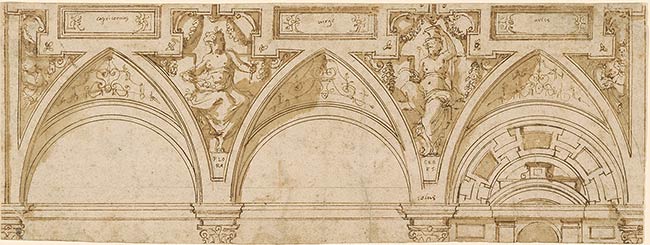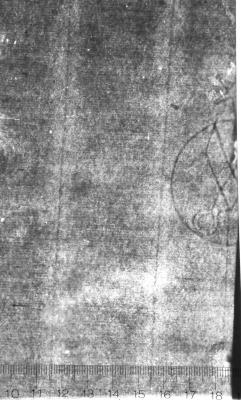
This drawing – along with five others in the Morgan’s collection – relates to Vasari’s frescoes for Bindo Altoviti’s villa in Rome, on which Vasari was working in 1553.1 At that time, Vasari was also engaged with fresco decorations for Altoviti’s palazzo across the river as well as those for the Villa Giulia, Rome, for Pope Paul III.2 The Villa Altoviti’s frescoes were destroyed around 1864 and the general appearance of the loggia is unrecorded. However, a series of engravings by Tommaso Piroli, published in 1807, records the appearance of nine deities and personifications of the four seasons from the fresco cycle.3 The present drawing, along with inv. 1984.61.1, prepare the decoration of a loggia with three bays, though their connection to the Villa Altoviti frescoes is indirect. These two fragments include four deities – Bacchus, Vertumnus, Flora and Ceres. Bacchus, Flora and Ceres were reproduced in Piroli’s prints, but only the figure of Bacchus matches (in reverse) that of the Morgan studies. Furthermore, the format of the Morgan designs for the vault of a loggia differ from the format of Piroli’s prints.4 The Morgan designs for a loggia may therefore belong to an early phase in Vasari’s designs for the villa. The Morgan sketches are most likely fragments of a larger ceiling design that was cut up, possibly by Vasari himself.
Footnotes
- Morgan Library & Museum, New York, inv. 1984.61.1; 1984.62.1; 1984.62.2; 1984.64.1; 1984.64.2.
- Härb 2015, 317. Altoviti’s palazzo was demolished in 1888, though its frescoes representing the twelve months, two river gods, and a Tribute to Ceres, were transferred to the Palazzo Venezia, Rome.
- Davis 1979, figs. 1-13.
- Härb 2015, 318.
Traced with stylus on the verso.
One of six studies for a vaulted ceiling decoration. Although the specific project has not yet been identified, it has been tentatively related to a commission for the decoration of a loggia that Vasari received on 14 April 1545 from Don Pietro Tolledo, Viceroy of Naples.
Inscribed in framed tablets, in pen and brown ink, "capricornus; virgo; aires"; and below the figures, "FLO / RA; CER / ES". Beneath these inscriptions, on the springing of the arch, "eolus".
Watermark: Circle with a scissor inside (shear). Fragment.
Moscardo family, former owner.
Calceolari, marquis de, former owner.
Saint-Saphorin, Armand-François-Louis de Mestral de, 1738-1805, former owner.
Marmier, André, former owner.
Scholz, János, former owner.
Selected reference: Vitzthum 1966, 64; Thiem 1968, 150; Notre Dame and Birmingham 1970, 83-84, no. D33; Washington and New York 1973-74, no. 28; Ragghianti Collobi 1976, 62; Fellows Report 1989, 386; New Haven 1994, 27, no. 25; Prague 1996, 231; Corti 1996, 161; Fairbrain 1998, 2: 518; Boston and Florence 2003-04, 195, 421-24, no. 29f; Gregory 2012, 372; Härb 2015, 317-319, no. 161f.
Ryskamp, Charles, ed. Twenty-First Report to the Fellows of the Pierpont Morgan Library, 1984-1986. New York : Pierpont Morgan Library, 1989, p. 386.

